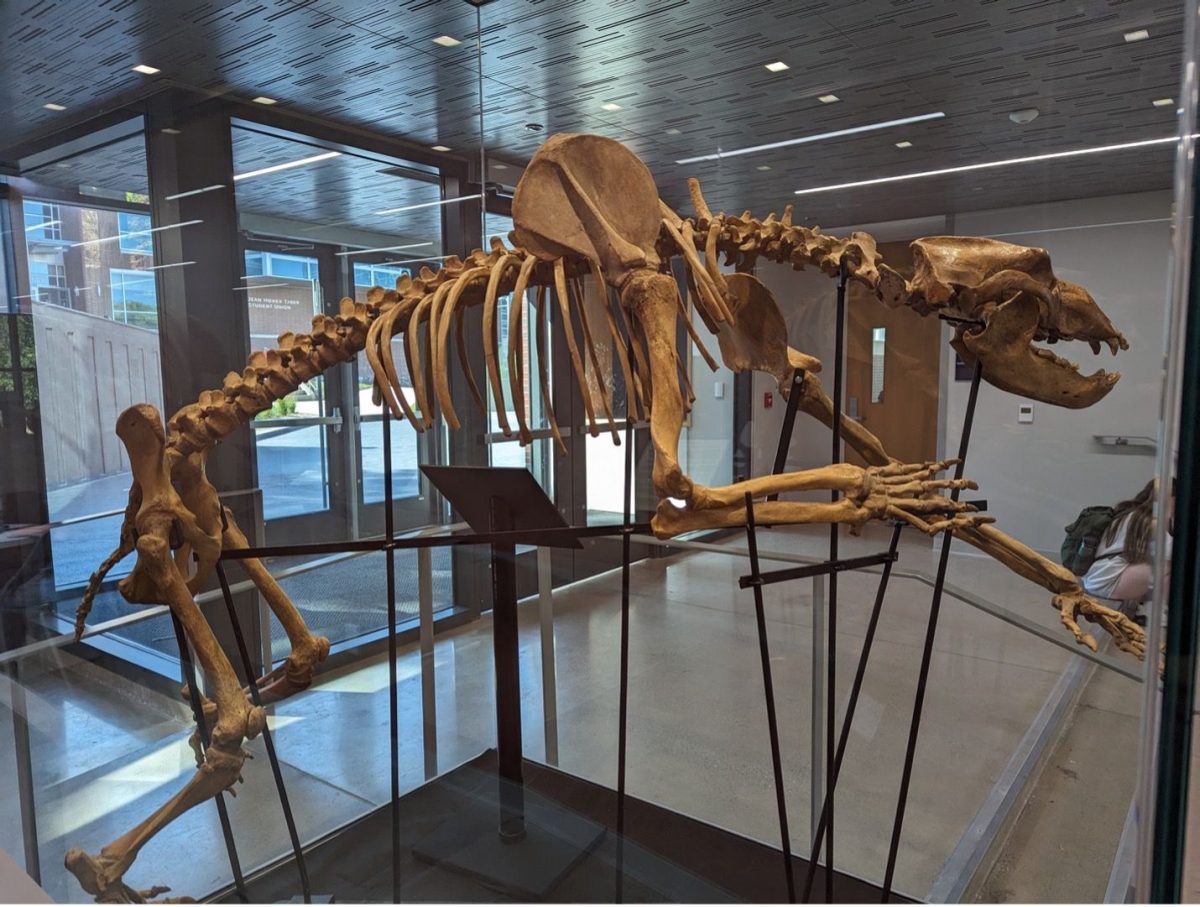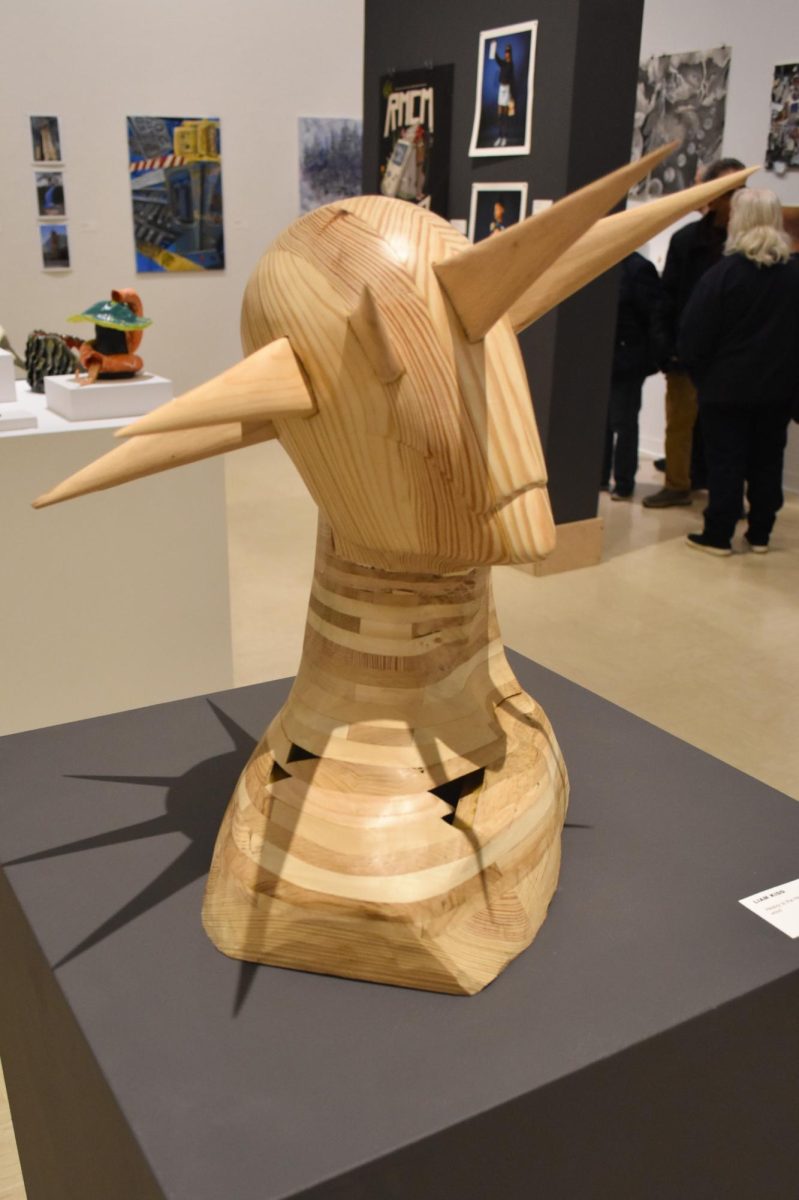On Tuesday, March 22, the main lights in the Emily Davis Gallery in the Myers School of Art at Folk Hall were turned off. You would expect something like this to mean that the gallery is closed, but there was a problem: the doors were opened, and to make it even more odd, people were inside enjoying artwork.
“
On Tuesday, March 22, the main lights in the Emily Davis Gallery in the Myers School of Art at Folk Hall were turned off. You would expect something like this to mean that the gallery is closed, but there was a problem: the doors were opened, and to make it even more odd, people were inside enjoying artwork.
The reason the lights were turned off was so that patrons to the gallery could enjoy the digitally projected pieces of artwork filling both levels of the gallery for the third Collider show entitled: ‘Collider 3: Transform.’ The reason why they were being digitally projected was that, unlike a traditional piece of artwork, these forms of artwork never truly live in a pure physical form, but on a very small piece of plastic where only half of the heart of the artwork resides, with the other half residing with whomever interacts with the piece.
At the show’s opening over 100 people showed up to interact with the pieces and the people around them,getting different results from the art every time someone different is involved with the piece.
But it did not stop there; during the following day, several classes showed up, some of them not even affiliated with any art classes, but classes just wanting to see an interesting show.
Tony Samangy, assistant professor in the Graphic Design Department, and Rod Bengston, director of the Emily Davis Gallery, both served as the curators for this exhibition.
Talking with Samangy, he said what made him want to do a show like Collider is the fine art program in the Myers School of Art needing a show like Collider for the students to experience art in a new media form. He said that this will be a continual program that students will look forward to, making the Collider name a familiar one as long as The University of Akron, the Director and Dean deem the show valid and important for the students.
Many names were thrown around for the longest time, Samangy said of the show’s title. But we wanted something short and something that hinted at the idea of the collaboration of art. Design and technology is something to consider, but we wanted something that was impactful that made it apparent that these different fields have to collaborate, and Collider just had this vision of art, design and technology coming together — not just sitting there happening together, but being forced together.
There are challenges that come with planning such an exhibition, where it took around six to eight months to form the list of the artists and to get their commitments for the pieces so that they would fit perfectly with one another in terms of concept and of their actual size.
My work is not about creating an object, but creating an environment that creates an experience for people coming into this environment, said Eunsu Kang, assistant professor in the New Media Department at the Myers School of Art, who is one of the artists who has a piece in the show. Kang’s piece is entitled ‘Shin’m,’ which is derived from several Korean words, ‘shin’ meaning body and ‘m’ meaning sound. To operate this piece, the viewer puts on a jacket fitted with lights on the palms of the hands. A camera on the ceiling will read the lights, and respond by producing sounds and projections on the walls and floor.
There was a dream where I am in the middle of a bridge between two islands, surrounded by people that I know, Kang said of his inspiration. Everyone was looking at me, and I was looking at them, and then they started to look like they were smearing away. I was looking at them, wondering why they were changing, but later realizing my body was transforming into water, especially my eyes. When I woke up, it made me realize that the world is based on my own perception of the world ever-changing, evolving and adjusting to people looking at it.
Kang had wanted to include speakers in the jacket to play a soundtrack of bubbles. Because of how small the speakers would need to be, they would produce static sounds here and there, reducing the quality of the overall piece with one slight imperfection. Apart from this concept, everything else was made with Kang’s original idea in mind.
Graham Wakefield and Haru Ji developed the piece entitled ‘Artificial Nature,’ which captures human movement and directional control to make digital images move around. This was made around a series the two artists have been working on entitled ‘Artificial Natures.’
Wakefield and Ji’s initial inspiration for making this piece comes from nature herself, particularly childhood memories of discovery and play within the complex systems of streaming rivers, ant trails and so on. With these raw experiences, they become encounters with the fascinating and alien properties of the environment we inhabit; and especially at early ages they come relatively un-mediated, un-tutored and un-cultured, yet are powerful, sometimes playful, formative.
To truly capture an experience that fully embodies the viewer while interacting with the piece, three projections were set up to surround the viewer, combined with a depth camera to detect the position and motions, projecting these as effect within the fluid medium of the virtual environment, within which various organisms metabolize and reproduce.
Philomène Longpré’s piece, ‘Formica,’ the Latin word for ant, was made with the complexity of the relationship between humans and machines, with ‘Formica’ creating the emotional, sensory and physical lines between the projected characters and visitors involved in the installation. Trying to get the piece to the gallery was a challenge; since it is a very popular piece, many galleries have reserved it.
Longpré said the idea came to her back in 1999 when she focused on conceptualizing and creating various interactive video systems where the visitor, as a part of the work system and subject to its rules, affects communication with a virtual character projected onto a robotic structure representing its environment.
My work is an exploration or the space between the material and the virtual worlds, or the imagination and reality, said Longpré.
The main purpose of this installation, though, is for the viewer to choose observing the projected character or themselves in this sort of situation – deciding whether or not to become involved in the work.
Plus, the installation provokes the question of the impact of our actions. If the character truly reacts the way as I move around, can it be controlled at all? But most importantly, who is Formica?
Those interested still have a chance to view this show from now through April 16; hopefully, with enough interest, Collider 4 will be around the same time next year.
“











